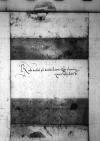Letter #5728
Sigismund I Jagiellon to Ioannes DANTISCUSCracow, 1546-09-20
| received Graudenz (Grudziądz), 1546-09-29 Manuscript sources:
| ||||
Text & apparatus & commentaryPlain textText & commentaryText & apparatus
Reverendo in Christo Patri, domino
Reverende in Christo Pater, domine sincere nobis dilecte.
Consilium Paternitatis Vestrae de dignitatibus distribuendis libenter amplexi sumus, quod illius iudicium cum nostro iudicio congruebat. Itaque quos nominavit Paternitas Vestra, eos maxime ex parte et nos illius commendatione adducti proveximus.
Paternitas Vestra bene valeat.
Dat(ae) or Dat(um)⌈Dat(ae)Dat(ae) or Dat(um)⌉
Commissio s(acrae) or s(erenissimae)⌈s(acrae)s(acrae) or s(erenissimae)⌉ regiae maiestatis propria


 BNW, BOZ, 953, f. 264v
BNW, BOZ, 953, f. 264v